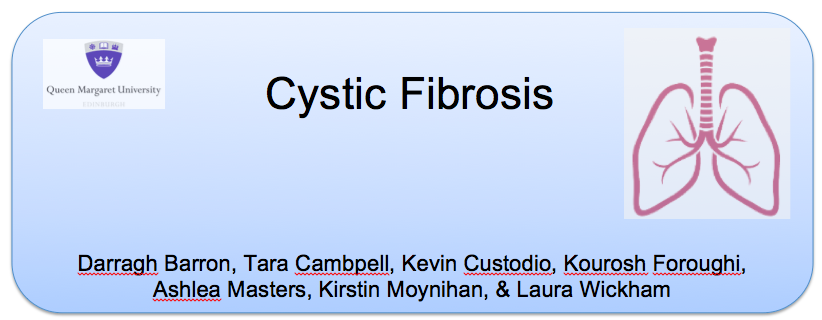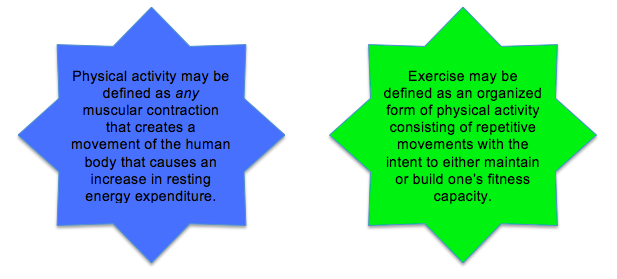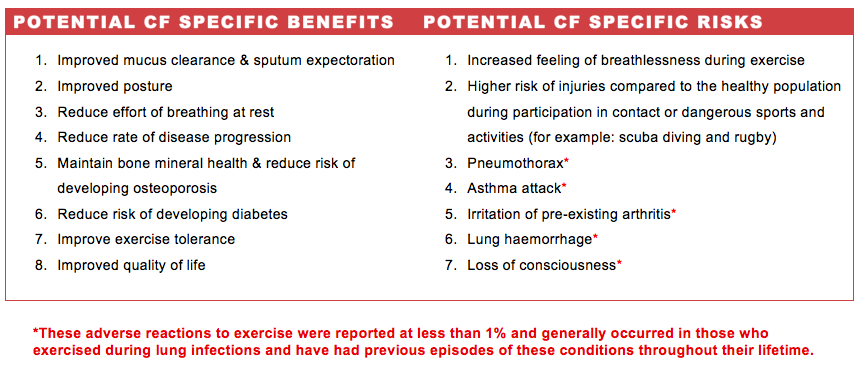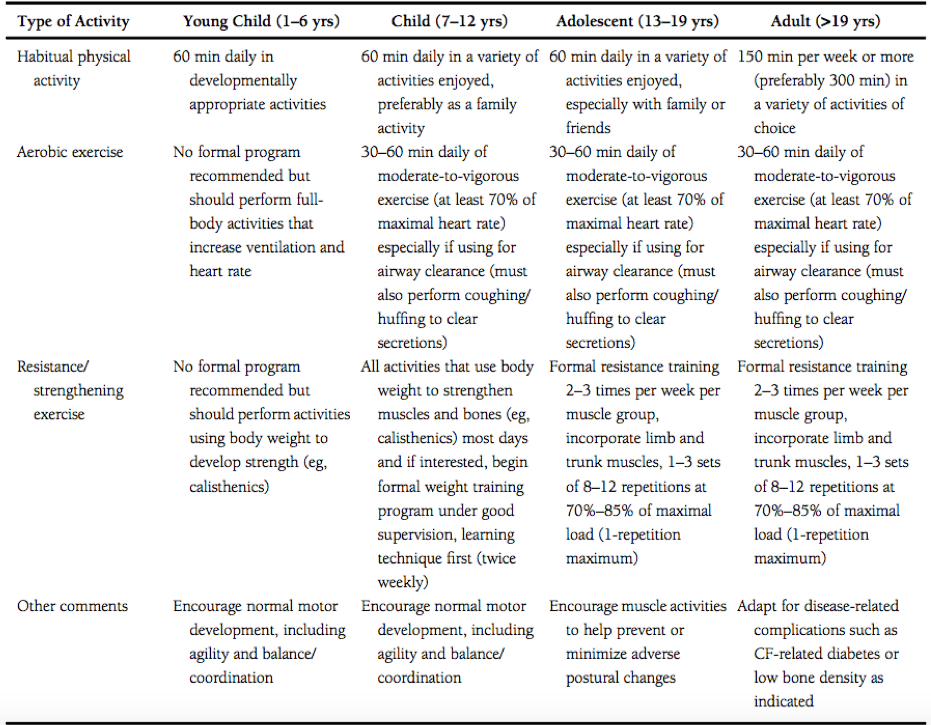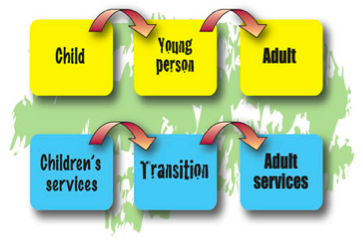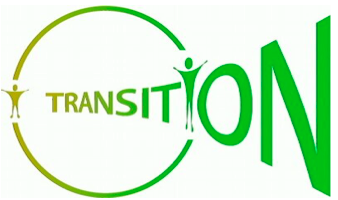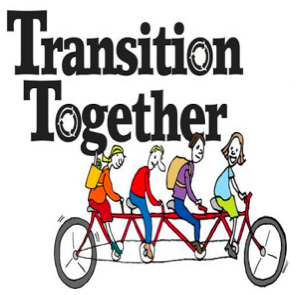Growing up With Cystic Fibrosis: Difference between revisions
No edit summary |
No edit summary |
||
| Line 189: | Line 189: | ||
Preparation, planning and communication by every participant (healthcare team, family and the individual) are key for a successful transition. This could be through ensuring the individual has been educated about CF and has the skills training to manage their long-term condition. If not, it is important to contact the relevant CF team member to address any concerns. | Preparation, planning and communication by every participant (healthcare team, family and the individual) are key for a successful transition. This could be through ensuring the individual has been educated about CF and has the skills training to manage their long-term condition. If not, it is important to contact the relevant CF team member to address any concerns. | ||
[http://www.rbht.nhs.uk/patients/condition/cystic-fibrosis/cystic-fibrosis-transition/transition-clinics/ Specific CF clinics] were another componenet found to be important for successful transitions. Your CF team should provide you with the relevant information about these clinics. | [http://www.rbht.nhs.uk/patients/condition/cystic-fibrosis/cystic-fibrosis-transition/transition-clinics/ Specific CF clinics] were another componenet found to be important for successful transitions. Your CF team should provide you with the relevant information about these clinics. | ||
It has been shown that young people with CF experience an effective transition when these is an are the opportunity for a joint meeting with the paediatric and adult services, a visit to the adult service before transition and having their first appointment made for them. If this is not the case, this should be highlighted with the CF team to ensure optimal transition (Craig et al. 2007, Steinbeck & Brodie 2006). | It has been shown that young people with CF experience an effective transition when these is an are the opportunity for a joint meeting with the paediatric and adult services, a visit to the adult service before transition and having their first appointment made for them. If this is not the case, this should be highlighted with the CF team to ensure optimal transition (Craig et al. 2007, Steinbeck & Brodie 2006). | ||
Revision as of 19:33, 18 November 2016
- Please do not edit unless you are involved in this project, but please come back in the near future to check out new information!!
- If you would like to get involved in this project and earn accreditation for your contributions, please get in touch!
Original Editor - Your name will be added here if you created the original content for this page.
Top Contributors - Laura Midori Wickham, Kim Jackson, Vidya Acharya, 127.0.0.1, Rachael Lowe, Michelle Lee, Naomi O'Reilly, WikiSysop and Adam Vallely Farrell
WELCOME[edit | edit source]
Introduction[edit | edit source]
Welcome to our information page for all people caring for individuals living with cystic fibrosis (CF). As we live in a world of technology, there are many CF websites available for public access on the Internet. Thus, our page is designed to build upon previous resources available and condense valuable information through our own critical analysis. It is our objective to provide parents and carers with a learning resource and developmental tool to ease concerns. We aim to achieve this through discussions of six important aspects of living with CF, thereby promoting self-efficacy towards assisting in the implementation of necessary changes or provide continued support.
Our mission is to advance the knowledge and participation among all readers to be well informed to assist individuals living with cystic fibrosis.
Our vision is that all readers will understand the disease and overall impact that it has for all those affected by CF. Additionally readers will be confident in assisting with the choice of appropriate treatments and become proactive about implementing any changes.
Please feel free to click on the video below to become familiar with the content our webpage has to offer and to learn how to navigate the site.
Video to come...
Learning Outcomes[edit | edit source]
After exploring this wiki page, the reader should be able to:
- Review evidence of new and emerging treatments and or management of people with CF
- Analyze the physiotherapist’s role through the transition from paediatric to adult services for individuals with CF - good depth
- Gain insight on managing and caring for people with CF
- To accurately justify and support the use of current physiotherapy treatments and management techniques for people who suffer from cystic fibrosis.
- Better understand your condition (CF), how to manage it and how others can help you.
- Compare the research substantiating new scientific evidence and treatments available in the paediatric cystic fibrosis field
- Critically analyse the research supporting new and emerging scientific evidence and treatment available for patients with cystic fibrosis
- Cope, aid and problem solve emotional and psychological problems themselves or their children/patients may have as a result of living with cystic fibrosis.
- Identify exercises to develop physical activity plans appropriate for the individual’s level of abilities.
PATHOPHYSIOLOGY OF CYSTIC FIBROSIS[edit | edit source]
K.F's content to come...
Check Point: Try these self-assessment questions below[edit | edit source]
EMOTIONAL AND PSYCHOLOGICAL IMPACT[edit | edit source]
K.C's info to come...
Check Point: Try these self-assessment questions below[edit | edit source]
PHYSIOTHERAPY TREATMENTS[edit | edit source]
T.C's info to come...
Check Point: Try these self-assessment questions below[edit | edit source]
EXERCISE[edit | edit source]
It is important to understand that not all physical activity is considered exercise. Be aware of the difference between exercise and physical activity. We encourage you to make a conscious effort to engage in planned activities regularly to become an exerciser!
Benefits and Risks[edit | edit source]
All exercisers should be aware of the benefits and risks involved in their leisure-time physical activity in order to self-motivate and pre-plan for known dangers. Individuals with CF are particularly vulnerable in respect to their reduced pulmonary function and we suggest adopting a preventative strategy, such as supervision and emergency protocols.
In addition to the benefits outlined specifically for those with CF, universal exercise benefits are applicable. For instance, exercise has been shown to generate positive effects on mood and lowers anxiety. Research also tells us that good experiences of physical activity can promote self-efficacy thereby increasing one’s confidence. All of which are psychological benefits that those living with CF may enjoy to experience the same as their healthy peers.
Exercise Prescription[edit | edit source]
Recently, there has been a significant amount of research regarding the use of exercise as “medicine” to benefit individuals living with cystic fibrosis. Such studies are important for determining the physical capacity at which these individuals are capable of enduring. Furthermore, an accumulation and examination of the results allows for clinicians to determine appropriate guidelines specifically designed for individuals with cystic fibrosis.
Swisher et al. developed specific exercise prescription for individuals of all ages living with cystic fibrosis, which can be viewed in the table below. It is however important to note that although these guidelines were developed by exercise and medical professionals, the onus is on the individual and their supportive team to adapt the prescription to fit the needs, capabilities and safety of the person performing the activity.
Exercise is often prescribed as a combined treatment for CF with traditional respiratory physiotherapy techniques because movements are able to affect the physiological function of the body. For example, the movement of the body during exercise may help to condition the muscles thereby maintaining proper posture prevent curvatures in the spine that can ultimately lead to compression of the torso, which affects the ability to expand the chest during inhalation. Schindel et al. examined this idea in detail with a gold standard study design, whereby the research suggests that maintaining posture through mobility, stretching and aerobic exercise can positively affect lung function, particularly for those with cystic fibrosis. Furthermore, Pedersen and Saltin explain that the movements produced by exercise can stimulate optimal function of the mucociliary transport system within the lungs to aid in easier clearance of excess mucus due to the disease. With less mucus in the lungs there may be less chance of chest infections as well as better quality of normal breathing experienced. Such improvements in ventilation will allow the body to naturally increase the amount of air available for gaseous exchange in the lungs thereby increasing oxygen into the blood and ultimately successful amending the individual’s oxygen saturation measures (Kriemler et al., 2016). Aside from exercises helping functions directly related to the pulmonary system, it may also be used to decrease the chance of acquiring co-morbidities such as osteoporosis and diabetes.
It seems that half of the battle to exercising is making it fun and enjoyable. The ability to choose the type of activity is one way to give individuals with CF autonomy in their life and leads to greater personal satisfaction, confidence and adherence (Orenstein & Higgins, 2005). This is especially important to implement early because it can help the individual to adopt this behaviour as a long term healthy habit and even encourage continuance throughout one’s life. Another way to bring about intrinsic motivation is to encourage the exerciser with appropriate music. A recent study showed that different types of music might be used to help distract the mind from thoughts about their high level of exertion and even reduce vital signs (Calik-Kutukcu et al., 2016). Both motivational and relaxation music appear to have equal effect regarding these outcomes, therefore it is personal preference as to which sound to listen to (Calik-Kutukcu et al., 2016). This provides the exerciser with another opportunity to participate in the decision-making aspect of exercising.
Check Point: Try these self-assessment questions below[edit | edit source]
- What is the difference between physical activity and exercise?
- How can exercise be used to help the physical function and overall lifestyle of those living with CF?
EMERGING RESEARCH[edit | edit source]
A.M's info to come...
ACADEMIC INSTITUTION INVOLVEMENT[edit | edit source]
Communication
[edit | edit source]
Infection Risk
[edit | edit source]
Top tips from parents[edit | edit source]
TRANSITION FROM PAEDIATRIC TO ADULT CARE[edit | edit source]
What is transition in Cystic Fibrosis?
Transition in CF has been described as “a purposeful, planned preparation of patients, families and caregivers for transfer of the patient to an adult program” (Flume, 2001).
Please click on this link to watch a Cystic Fibrosis transition film:
www.rbht.nhs.uk/patients/condition/cystic-fibrosis/cystic-fibrosis-transition/transition-film/
Need For Transfer[edit | edit source]
Why do children need to transfer to an adult service?
Cystic fibrosis is no longer a condition the only affects children. Individuals with cystic fibrosis have a greater lifespan, and there are currently more adults with cystic fibrosis than children.
There is a requirement to react to the developing maturity of adolescents with cystic fibrosis. They must be involved in decisions regarding their care and treatment. This should begin as soon as possible in the paedriatric service and continue within the adult service.
Adolescents may not realise the need for transfer to begin with but it will become relevant to them as they mature, gain independence, interests and develop new relationships.
They will have to deal with managing their health and treatment along with education, career and relationships in the future. Therefore, it is necesssary that they start to understand how their feelings and attitude about their health and treatment will infuence their future well-being (Cystic Fibrosis Trust, 2013).
Differences Between Services[edit | edit source]
What differences are there between the paediatric and the adult CF services?
The paediatric service team work mainly with the parents rather than the child with CF. The parents are shown how to care for their child and manage their treatment. The childs decisions are made for them rather than with them. However, this gradually changes as the child develops and they will activily engage in making decisions with regard to their care (Fegran et al. 2013).
The adult service works directly with the individual with CF. The individuals should now be involved in the planning and delivery of health services under the guidance of the CF team (Oppong-Odiseng, 1997; Dodd, 1996; DH, 2006). The team aims to incorporate the treatment with the patient’s lifestyle and give emotional support to the individual as issues arise.
Parents and carers may still remain involved, however their role becomes supportive once the individual has transferred.
Timing[edit | edit source]
When should the discussion of transition begin?
The discussion of transition should begin at least a year before the transfer to adult services occurs. This provides the individual and their parent/caregiver with sufficient time to consider feelings and settle any worries either may have (Cystic Fibrosis Trust, 2013).
When does the transfer to adult services happen?
The timing of transfer is different for individuals and is dependent on their requirements. However, to prevent premature or late transfer, it is advised that transfer should occur between the ages of 14 and 18 (Conway, 2004).
Barriers[edit | edit source]
Transition to adult care for young people with CF can be ineffective when there is:
- A lack of support of the transition process by any of the participants, which include the health care teams, adolescents and families, and the health care system;
- Limited preparation for transition;
- Lack of regular communication between participants (Towns and Bell, 2010).
Effective Transitioning[edit | edit source]
Preparation, planning and communication by every participant (healthcare team, family and the individual) are key for a successful transition. This could be through ensuring the individual has been educated about CF and has the skills training to manage their long-term condition. If not, it is important to contact the relevant CF team member to address any concerns.
Specific CF clinics were another componenet found to be important for successful transitions. Your CF team should provide you with the relevant information about these clinics.
It has been shown that young people with CF experience an effective transition when these is an are the opportunity for a joint meeting with the paediatric and adult services, a visit to the adult service before transition and having their first appointment made for them. If this is not the case, this should be highlighted with the CF team to ensure optimal transition (Craig et al. 2007, Steinbeck & Brodie 2006).
Expected Changes[edit | edit source]
What changes may I expect as a parent?
Adolescents gradually become more independent and they are capable of making important decisions for themselves such as education or career path. However, they may still require support in more difficult choices such as ones involving medical treatments and surgeries.
It can be difficult as a parent to step back and allow adolescents to take charge of their care. Adolescents may be asked for advice, however this may be ignored. It is important to remember that all parents experience this as their children mature.
It is important to be able to take a step back and discuss with the child to what is it they want. They might want to continue discussing health issues as they arise but might not want to be told what to do. The role of advisor will now change to that of a counselor.
You may not always agree with the adolescents’ opinions, however it must be respected. This can be challenging for a parent but most adult services are familiar with these problems and are there for support during difficult times (Cystic Fibrosis Trust, 2013).
Role of Physiotherapists[edit | edit source]
CONCLUSION[edit | edit source]
Planning for the Future[edit | edit source]
Recent Related Research (from Pubmed)[edit | edit source]
Extension:RSS -- Error: Not a valid URL: Feed goes here!!|charset=UTF-8|short|max=10
REFERENCES[edit | edit source]
References will automatically be added here, see adding references tutorial.
